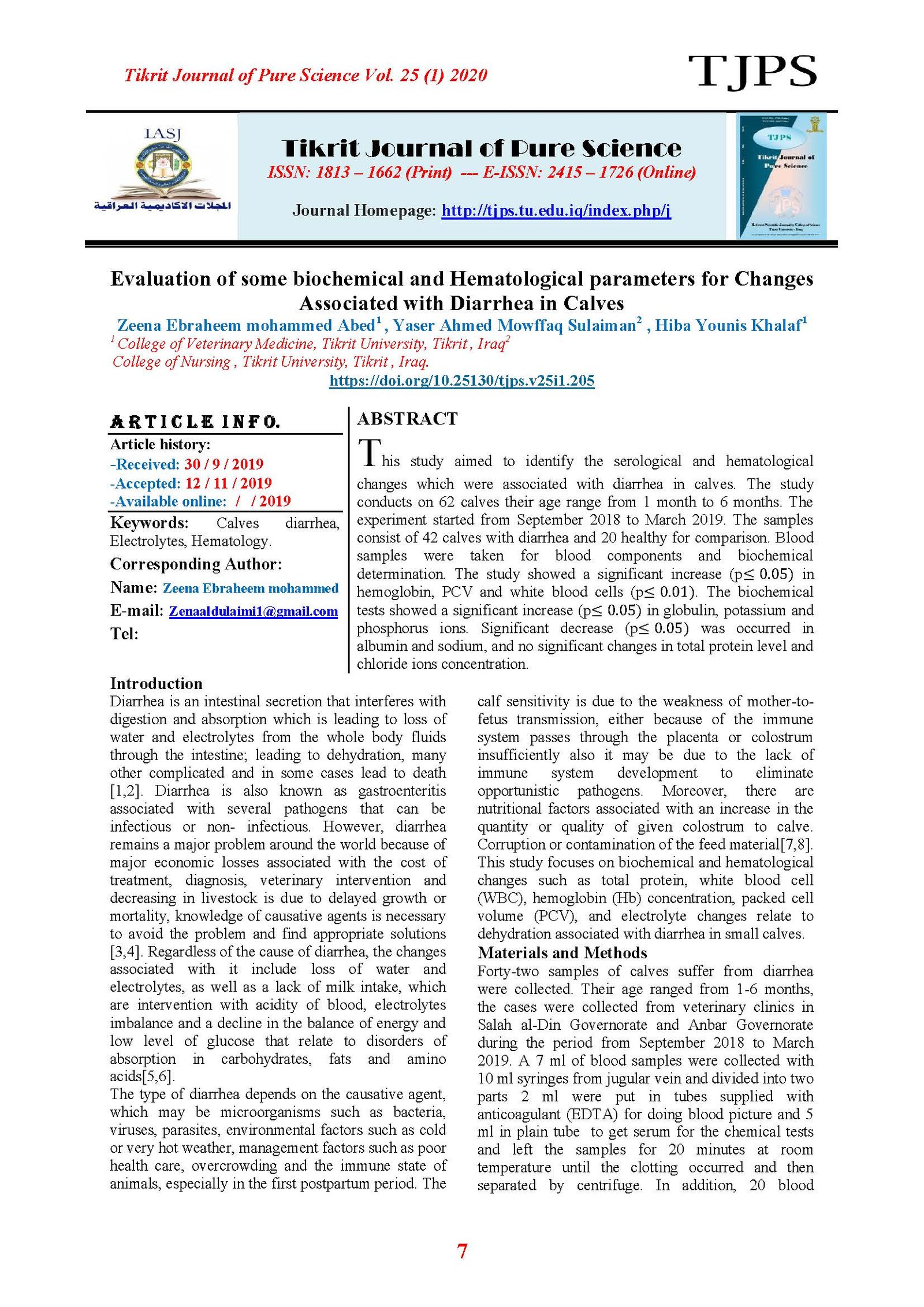Evaluation of some biochemical and Hematological parameters for Changes Associated with Diarrhea in Calves
Main Article Content
Abstract
This study aimed to identify the serological and hematological changes which were associated with diarrhea in calves. The study conducts on 62 calves their age range from 1 month to 6 months. The experiment started from September 2018 to March 2019. The samples consist of 42 calves with diarrhea and 20 healthy for comparison. Blood samples were taken for blood components and biochemical determination. The study showed a significant increase (p in hemoglobin, PCV and white blood cells (p . The biochemical tests showed a significant increase (p in globulin, potassium and phosphorus ions. Significant decrease (p was occurred in albumin and sodium, and no significant changes in total protein level and chloride ions concentration.
Article Details

This work is licensed under a Creative Commons Attribution 4.0 International License.
Tikrit Journal of Pure Science is licensed under the Creative Commons Attribution 4.0 International License, which allows users to copy, create extracts, abstracts, and new works from the article, alter and revise the article, and make commercial use of the article (including reuse and/or resale of the article by commercial entities), provided the user gives appropriate credit (with a link to the formal publication through the relevant DOI), provides a link to the license, indicates if changes were made, and the licensor is not represented as endorsing the use made of the work. The authors hold the copyright for their published work on the Tikrit J. Pure Sci. website, while Tikrit J. Pure Sci. is responsible for appreciate citation of their work, which is released under CC-BY-4.0, enabling the unrestricted use, distribution, and reproduction of an article in any medium, provided that the original work is properly cited.
References
[1] Dratwa - Chałupnik, A.; Herosimczyk, A.; Lepczyński, A. and Skrzypczak, W. F. (2012). Calves with diarrhea and a water-electrolyte balance. Medycyna Weterynaryjna, 68(1), 5-8.
[2] Fortuoso, B. F., Volpato, A., Rampazzo, L., Glombowsky, P., Griss, L. G., Galli, G. M.et al. (2018). Homeopathic treatment as an alternative prophylactic to minimize bacterial infection and prevent neonatal diarrhea in calves. Microbial pathogenesis, 114, 95-98.
[3] Coura, F. M.; Freitas, M. D.; Ribeiro, J.; de Leme, R. A.; de Souza, C.; Alfieri, A. A.; et al. (2015). Longitudinal study of Salmonella spp., diarrheagenic Escherichia coli, Rotavirus, and Coronavirus isolated from healthy and diarrheic calves in a Brazilian dairy herd. Tropical animal health and production, 47(1), 3-11.
[4] Nasser, N. I. (2014). Frequency of Parasitic, Bacterial and Fungal Enteropathogens among Children and Adults Patients with Diarrhea and Association Affecting Factors. kufa Journal for Nursing sciences, 4(3), 169-175.
[5] Golbeck, L.; Cohrs, I.; Leonhard - Marek, S.; and Grünberg, W. (2018). Effect of dehydration and acidemia on the potassium content of muscle tissue and erythrocytes in calves with neonatal diarrhea. Journal of dairy science, 101(10), 9339-9349.
[6] Tsukano, K.; Ajito, T.; Abe, I.; Sarashina, S.; and Suzuki, K. (2017). Rehydration and catabolic preventive effects depend on the composition of oral electrolyte solutions for diarrheic calves. Journal of Veterinary Medical Science, 17-0398. [7] Khalaf, H.Y. (2013). Isolation and Identification of causative agent bacteria and fungi causes diarrheal cases in cows and calves. Tikrit University Journal of Agricultural Science.13(3),122-127. [8] Bozukluhan, K., Merhan, O., Gokce, H. I., Deveci, H. A., Gokce, G., Ogun, M., et al. (2017). Alterations in lipid profile in neonatal calves affected by diarrhea. Veterinary world, 10 (7), 786. [9] Singh, M.; Gupta, V. K.; Mondal, D. B.;Bansal, S. K.; Sharma, D. K.; Shakya, M.et al. (2014). A study on alteration in Haemato-biochemical parameters in Colibacillosis affected calves. International Journal, 2(7), 746-750. [10] Shekhar, S.; Ranjan, R.; Singh, C. V.; and Kumar, P. (2017). Prevalence, Clinicohaemato-Biochemical alterations in colibacillosis in neonatal calves. International Journal Current Microbiology And Appllied Sciences, 6(9), 3192-3198.
[11] Gharieb, R. M.; Fawzi, E. M.; Attia, N. E.; and Bayoumi, Y. H. (2015). Calf diarrhea in Sharkia province, Egypt: diagnosis; prevalence, virulence profiles and zoonotic potential of the causal bacterial agents . International Journal of Agriculture Sciences And Veternary Medecine. [12] Santos, R. L.; Tsolis, R. M.; Bäumler, A. J. and Adams, L.G. (2002). Hematologic and serum biochemical changes in Salmonella ser Typhimurium - infected calves. American journal of veterinary research, 63(8), 1145-1150.
[13] Alkhafaji, I. J., and Mahmood, A. K. (2016). The
study of biochemical ions parameters of non-diarrheic and diarrheic Iraqi Awassi suckling lambs. Al-Anbar Journal of Veterinary Sciences, 9(2), 110-113. [14] Sharma, S. K. (2013). Epidemiological, Clinical and Haemato-biochemical Characterization of Calf Diarrhoea and Evaluation of Therapeutic Regimens . Unpublished Doctoral dissertation, Rajasthan University of Veterinary and Animal Sciences, Bikaner-334001).
[15] Guzelbektes, H., Coskun, A.; and Sen, I. (2007). "Relationship between the degree of dehydration and the balance of acid-based changes in dehydrated calves with diarrhea". Bulletin –Veterinary institute in pulawy, 51(1), 83.
